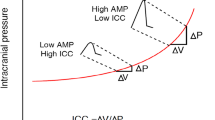Abstract
Background
Reference values and physiological measurements of intracranial pressure (ICP) are primarily reported in the supine position, while reports of ICP in the vertical position are surprisingly rare considering that humans maintain the vertical position for the majority of the day. In order to distinguish normal human physiology from disease entities such as idiopathic intracranial hypertension and normal pressure hydrocephalus, we investigated ICP in different body postures in both normal and ill subjects.
Methods
Thirty-one patients were included: four normal patients following complete removal of a solitary clearly demarcated small brain tumour and fitted with a telemetric ICP monitoring device for long-term ICP monitoring; 27 patients requiring invasive ICP monitoring as a part of their diagnostic work-up or monitoring of shunt treatment effect. ICP was recorded in the following body positions: upright standing, sitting in a chair, supine and right lateral lumbar puncture position.
Results
Linear regression of median ICP based on patient posture, group, and purpose of monitoring presented a significant model (p < 0.001), but could not distinguish between patient groups (p = 0.88). Regression of differences in median ICP between body postures and supine ICP as the baseline, presented a highly significant model (p < 0.001) and adjusted R 2 = 0.86. Both body posture (p < 0.001) and patient group (p < 0.001) were highly significant factors.
Conclusions
Differences in ICP between body postures enabled us to distinguish the normal group from patient groups. Normal patients appear able to more tightly regulate ICP when switching body postures.



Similar content being viewed by others
References
Andresen M, Juhler M (2014) Intracranial pressure following complete removal of a small demarcated brain tumor: a model for normal intracranial pressure in humans. J Neurosurg 121:797-801
Andresen M, Juhler M, Munch TN (2012) Quality and safety of home ICP monitoring compared with in-hospital monitoring. Acta Neurochir Suppl 113:187–191
Brimioulle S, Moraine J-J, Norrenberg D, Kahn RJ (1997) Effects of positioning and exercise on intracranial pressure in a neurosurgical intensive care unit. Phys Ther 77(12):1682–1689
Cook SW, Bergsneider M (2002) Why valve opening pressure plays a relatively minor role in the postural ICP response to ventricular shunts in normal pressure hydrocephalus: modeling and implications. Acta Neurochir Suppl 81:15–17
Hung OR, Hare GM, Brien S (2000) Head elevation reduces head-rotation associated increased ICP in patients with intracranial tumours. Can J Anaesth 47(5):415–420
Kajimoto Y, Ohta T, Miyake H, Matsukawa M, Ogawa D, Nagao K, Kuroiwa T (2000) Posture-related changes in the pressure environment of the ventriculoperitoneal shunt system. J Neurosurg 93(4):614–617
Ledwith MB, Bloom S, Maloney-Wilensky E, Coyle B, Polomano RC, Le Roux PD (2010) Effect of body position on cerebral oxygenation and physiologic parameters in patients with acute neurological conditions. J Neurosci Nurs 42(5):280–287
Lee S-T (1989) Intracranial pressure changes during positioning of patients with severe head injury. Heart Lung 18(4):411–414
Loman J, Myerson A, Goldman D (1935) Effects of alterations in posture on the cerebrospinal fluid pressure. Arch Neurol Psychiatr 33(6):1279–1295
Magnaes B (1976) Body position and cerebrospinal fluid pressure. Part 1: clinical studies on the effect of rapid postural changes. J Neurosurg 44(6):687–697
Mahfoud F, Beck J, Raabe A (2010) Intracranial pressure pulse amplitude during changes in head elevation: a new parameter for determining optimum cerebral perfusion pressure? Acta Neurochir (Wein) 152(3):443–450
Mavrocordatos P, Bissonnette B, Ravussin P (2000) Effects of neck position and head elevation on intracranial pressure in anaesthetized neurosurgical patients: preliminary results. J Neurosurg Anesthesiol 12(1):10–14
Ng I, Lim J, Wong HB (2004) Effects of head posture on cerebral hemodynamics: its influences on intracranial pressure, cerebral perfusion pressure, and cerebral oxygenation. Neurosurgery 54(3):593–597
Qvarlander S, Sundström N, Malm J, Eklund A (2013) Postural effects on intracranial pressure: modeling and clinical evaluation. J Appl Physiol 115(10):1474–1480
Schwarz S, Georgiadis D, Aschoff A, Schwab S (2002) Effects of body position on intracranial pressure and cerebral perfusion in patients with large hemispheric stroke. Stroke 33(2):497–501
Welschehold S, Schmalhausen E, Dodier P, Vulcu S, Oertel J, Wagner W, Tschan CA (2012) First clinical results with a new telemetric intracranial pressure-monitoring system. Neurosurgery 70(1 Suppl Operative):44–49
Winkelman C (2000) Effect of backrest position on intracranial and cerebral perfusion pressures in traumatically brain-injured adults. Am J Crit Care 9(6):373–380
Acknowledgments
The authors gratefully acknowledge support in the form of research grants from The Hetland Olsen Fund, The Aase og Ejnar Danielsen Fund, The Augustinus Fund and Dagmar Marshall’s Fund.
Conflicts of interest
All authors certify that they have no affiliations with or involvement in any organisation or entity with any financial or non-financial interest in the subject matter or materials discussed in this manuscript.
Author information
Authors and Affiliations
Corresponding author
Additional information
Conference presentations
Preliminary results were presented in abstract form at the 15th International Symposium on Intracranial Pressure, in Singapore, November 2013
Rights and permissions
About this article
Cite this article
Andresen, M., Hadi, A., Petersen, L.G. et al. Effect of postural changes on ICP in healthy and ill subjects. Acta Neurochir 157, 109–113 (2015). https://doi.org/10.1007/s00701-014-2250-2
Received:
Accepted:
Published:
Issue Date:
DOI: https://doi.org/10.1007/s00701-014-2250-2




